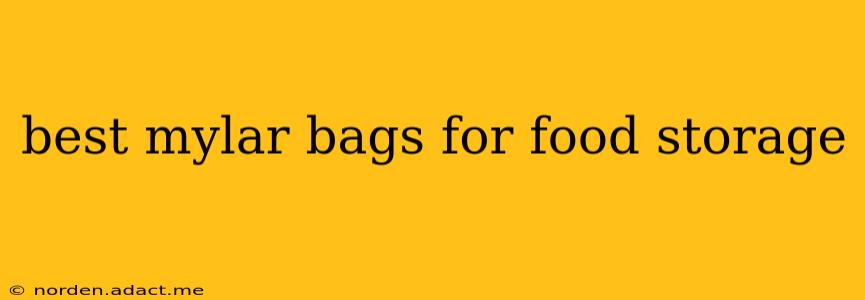Mylar bags, known for their exceptional ability to protect food from oxygen, moisture, and pests, have become a popular choice for long-term food storage. But with numerous options available, choosing the best mylar bags for your needs can be overwhelming. This comprehensive guide will delve into the key factors to consider, helping you select the perfect mylar bags to preserve your food's quality and extend its shelf life.
What Makes a Mylar Bag Ideal for Food Storage?
Mylar bags, technically made from a polyester film coated with aluminum, offer superior protection against the elements that spoil food. Their airtight, multi-layered construction creates a barrier against:
- Oxygen: Oxygen is a major contributor to food spoilage, causing oxidation and rancidity. Mylar bags significantly reduce oxygen exposure.
- Moisture: Moisture can lead to mold growth and bacterial contamination. Mylar bags' low moisture vapor transmission rate (MVTR) helps maintain dryness.
- Light: Sunlight and UV light can degrade food quality. Mylar bags' opacity helps shield food from harmful light.
- Pests: Insects and rodents are deterred by the strong, airtight seal of a quality mylar bag.
Factors to Consider When Choosing Mylar Bags for Food Storage
Several key factors influence the effectiveness and suitability of mylar bags for food preservation:
1. Size and Capacity:
The size of the mylar bag should match the amount of food you intend to store. Overfilling can compromise the seal, while underfilling wastes space and potentially reduces the bag's effectiveness. Consider the volume of your food items and choose a bag size accordingly. Many retailers offer bags in a wide variety of sizes, from small pouches for spices to large bags capable of holding several gallons of grains.
2. Material Thickness (Mil):
Mylar bags are measured in "mil," which refers to the thickness of the material (1 mil = 0.001 inch). Thicker bags (7-12 mil) provide better protection against punctures, tears, and light penetration, making them ideal for long-term storage. Thinner bags (5 mil) might suffice for shorter-term storage or items less susceptible to damage.
3. Sealability:
A reliable seal is crucial for maintaining the integrity of the bag and preventing air infiltration. Look for bags with features designed to ensure a tight seal, such as heat-sealable options or reliable zipper closures. Heat-sealing is generally recommended for longer-term storage as it creates a more airtight seal than zippers alone. However, zippers offer convenience for frequent access.
4. Type of Closure:
As mentioned above, choose bags with either a heat seal or reliable zipper closure, or both. Heat-sealing provides the best barrier against air and moisture, while zippers allow for easier access. Consider your personal preferences and storage needs when choosing between these closure types.
5. Additives and Safety:
Ensure the mylar bags you choose are food-safe and free from harmful chemicals or additives that could leach into your food. Reputable manufacturers will clearly label their bags as food-grade.
H2: What are the best materials for mylar bags used for food storage?
The best mylar bags are typically made from a combination of materials designed to optimize protection against various factors that can lead to food spoilage. The core material is usually a strong, durable polyester film, which provides structural integrity. This is then coated with a thin layer of aluminum foil, which acts as an effective barrier against light, oxygen, and moisture. An additional layer of polyethylene may be added to enhance the bag's durability and sealability. The precise composition of these layers might vary among different manufacturers, but this general structure is common for high-quality food storage mylar bags.
H2: How long can food be stored in mylar bags?
The length of time food can be safely stored in mylar bags depends on several factors including the type of food, its initial quality, the storage environment (temperature and humidity), and the quality of the mylar bags themselves. While mylar bags significantly extend shelf life, they are not indefinite storage solutions. Properly stored food in high-quality mylar bags can last for many years, often surpassing the "best by" dates found on commercial packaging. However, it is always advisable to regularly inspect your stored food for any signs of spoilage or deterioration before consumption. Regular rotation of stock is also beneficial in maintaining freshness.
H2: Are mylar bags reusable?
Mylar bags with zipper closures can be reused if they are properly cleaned and dried after each use. However, heat-sealed bags are generally not reusable, as resealing them reliably is difficult and may compromise the airtight seal. Zippered bags may be more susceptible to seal failure with repeated use, so using them for multiple storage cycles should be carefully considered based on the value of the contents.
Conclusion
Selecting the best mylar bags for food storage requires careful consideration of factors like size, thickness, sealability, and material safety. By understanding these key aspects, you can make an informed decision and invest in the right mylar bags to preserve your food, ensuring its quality and extending its shelf life for years to come. Remember to always check for food-grade certification and store your food in a cool, dark, and dry place.
